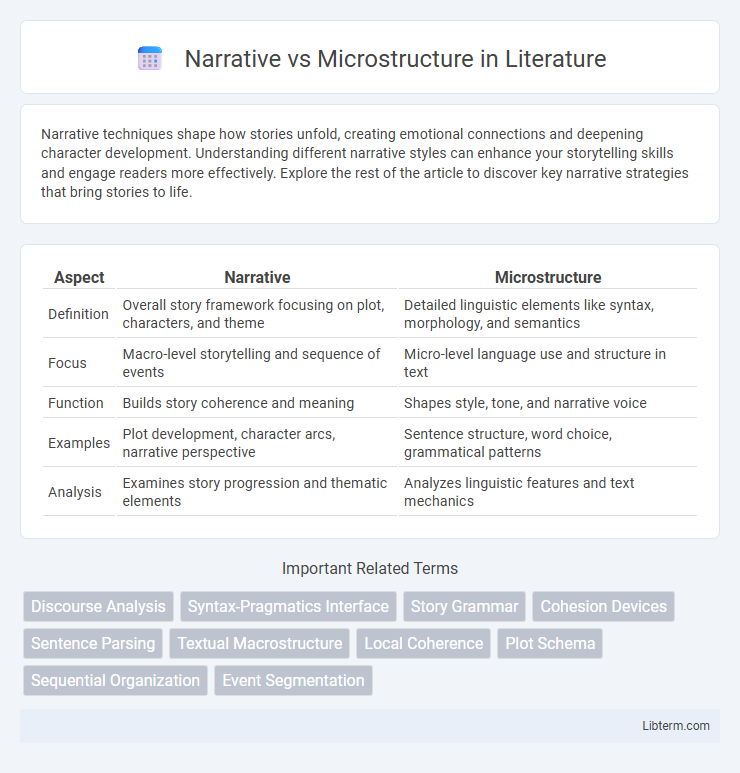Narrative techniques shape how stories unfold, creating emotional connections and deepening character development. Understanding different narrative styles can enhance your storytelling skills and engage readers more effectively. Explore the rest of the article to discover key narrative strategies that bring stories to life.
Table of Comparison
| Aspect | Narrative | Microstructure |
|---|---|---|
| Definition | Overall story framework focusing on plot, characters, and theme | Detailed linguistic elements like syntax, morphology, and semantics |
| Focus | Macro-level storytelling and sequence of events | Micro-level language use and structure in text |
| Function | Builds story coherence and meaning | Shapes style, tone, and narrative voice |
| Examples | Plot development, character arcs, narrative perspective | Sentence structure, word choice, grammatical patterns |
| Analysis | Examines story progression and thematic elements | Analyzes linguistic features and text mechanics |
Understanding Narrative and Microstructure
Understanding narrative involves exploring the overarching story, including plot, characters, and themes that convey meaning and evoke emotions. Microstructure focuses on the finer details such as sentence construction, word choice, and linguistic patterns that shape how the story is communicated. Analyzing both narrative and microstructure provides a comprehensive view of text interpretation and literary style.
Definitions: Narrative vs. Microstructure
Narrative refers to the structured story or sequence of events that convey a coherent message, emphasizing characters, plot, and temporal progression. Microstructure involves the detailed linguistic elements within the narrative, such as syntax, vocabulary, and discourse markers, that shape how the story is communicated. Understanding the distinction highlights how narratives provide the overarching content while microstructure reveals the underlying language mechanics that enhance meaning and engagement.
Core Elements of Narrative
Core elements of narrative include characters, setting, plot, conflict, and resolution, which collectively drive the story's meaning and emotional impact. Microstructure focuses on language details such as syntax, vocabulary, and cohesion that shape how the narrative is conveyed and understood. Understanding the interplay between narrative's core elements and microstructure enhances comprehension and analysis of texts in literature and communication.
Key Features of Microstructure
Microstructure in finance refers to the detailed mechanisms and processes that govern trading, including order types, bid-ask spreads, and market depth. Key features of microstructure include the analysis of price formation, liquidity provision, and the impact of information asymmetry on trading behavior. Understanding these elements is crucial for optimizing execution strategies and reducing transaction costs in financial markets.
Narrative’s Role in Storytelling
Narrative serves as the overarching framework that organizes events and characters into a coherent and meaningful story, guiding the audience through the plot's progression and thematic development. It shapes the emotional and psychological experience by providing context, motivation, and causality, allowing for deeper engagement and understanding. Unlike microstructure, which deals with detailed linguistic elements like syntax and word choice, narrative controls the overall direction and purpose of storytelling.
Microstructure’s Impact on Text Quality
Microstructure significantly influences text quality by shaping coherence, cohesion, and syntactic complexity at the sentence and paragraph levels. Enhanced microstructural elements such as effective referential ties, appropriate lexical choice, and grammatical accuracy contribute to clearer, more engaging narratives. Analytical studies demonstrate that strong microstructure predicts improved reader comprehension and overall communication effectiveness in both academic and creative writing.
Comparing Narrative Flow and Microstructure Precision
Narrative flow emphasizes the chronological and thematic progression of a story, creating a seamless and engaging reading experience. Microstructure precision focuses on the detailed linguistic features, such as syntax, coherence, and cohesion, ensuring clarity and depth in each sentence. Comparing narrative flow and microstructure reveals how global storytelling dynamics interact with local linguistic accuracy to enhance overall text quality.
How Narrative and Microstructure Interact
Narrative and microstructure interact by shaping the coherence and depth of a story through their complementary roles; narrative establishes the overarching plot and thematic progression, while microstructure details the linguistic and syntactic elements that influence readability and engagement. Effective interaction between narrative and microstructure enhances text cohesion, enabling readers to connect events meaningfully while appreciating stylistic nuances such as sentence variety and lexical choice. This interplay is crucial in fields like discourse analysis and computational linguistics, where understanding both macro-level story structure and micro-level language patterns improves narrative comprehension and generation.
Common Challenges in Balancing Both
Balancing narrative and microstructure often presents challenges such as maintaining coherence while integrating detailed data points seamlessly. Excessive focus on microstructure can overwhelm readers, detracting from the overarching story and reducing engagement. Ensuring clarity requires careful alignment of thematic elements with granular information to create a cohesive and compelling text.
Strategies for Integrating Narrative and Microstructure
Effective strategies for integrating narrative and microstructure include aligning thematic content with sentence-level elements such as syntax, morphology, and cohesion to enhance storytelling clarity and engagement. Utilizing discourse markers and lexical repetition reinforces narrative flow while maintaining microstructural coherence across paragraphs. Applying techniques like thematic progression and cohesive ties ensures a seamless connection between overall story development and detailed linguistic choices.
Narrative Infographic

 libterm.com
libterm.com